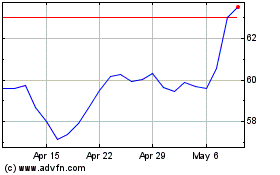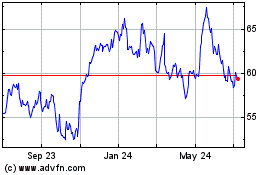Budweiser Brewer Issues Profit Warning, Sending Shares Sharply Lower -- 2nd Update
October 25 2019 - 9:13AM
Dow Jones News
By Saabira Chaudhuri
Anheuser-Busch InBev SA cut its full-year guidance after a
disappointing quarterly performance in the U.S. and China, sending
its shares 10% lower and underscoring the challenges the Budweiser
brewer faces despite moves to trim its enormous debt pile.
The world's biggest brewer has for years grappled with declining
volumes in the U.S. -- its largest market -- as Americans abandon
mainstream lagers such as Bud and Bud Light in favor of craft
beers, spirits and nonalcoholic drinks. In response, AB InBev has
tried to sell pricier beers in developed markets and increasingly
is pushing deeper into emerging markets by launching new affordable
brews.
But those efforts failed to stem the decline in the third
quarter. Sales growth continued to slow in the U.S., while sales in
China fell, hit by the government's moves to close nightclubs and
karaoke bars. Demand was also lower in Brazil and South Korea as
the company raised prices to offset higher costs.
Overall, organic revenue grew for the quarter came in at 2.7%,
missing analysts' estimates of 4.7%. AB InBev -- which makes one
out of every four beers globally and owns brands such as Stella
Artois and Beck's -- also missed forecasts on volume growth.
Underlying profit, which strips out gains tied to hedging and
the impact of hyperinflation, dropped to $1.87 billion from $2.19
billion. Net profit was $3 billion, up from $959 million. Revenue
rose to $13.17 billion from $12.92 billion.
In addition to the disappointing sales, the company blamed its
weaker quarterly earnings on higher commodity costs and marketing
expenses as well as foreign-exchange headwinds, and said the issues
would also hurt its full-year figures.
It now expects "moderate" rather than "strong" growth in
earnings before interest, taxes, depreciation and amortization for
the full year.
AB InBev has been working to reduce its debt, amassed after a
string of acquisitions including SABMiller. It recently agreed to
sell its Australia business and listed its Asia arm. On Friday, it
said it was on track to hit a net-debt-to-Ebitda ratio of below
four times by the end of 2019, a year earlier than it previously
expected.
The SABMiller deal was a key part of the company's strategy to
expand in emerging markets as volumes slow in the West.
AB InBev is shifting its focus from pushing pricier brands to
launching affordable brands and packaging in emerging markets.
The company described the affordability strategy as "a vital
component to reaching new consumers and introducing beer to new
occasions." In Colombia, the company has been selling more
one-liter beer bottles, in Brazil it is selling brands made with
ingredients grown by local farmers, and in Ecuador it launched a
new one-liter returnable glass bottle to keep prices down.
However, these efforts mean the company is generating less
revenue from each beer sold. AB InBev said revenue per hectoliter
grew 3% in the quarter, compared with 4.2% a year earlier. For the
full year, it said growth by that measure would be slightly below
inflation, having previously expected growth above inflation.
Volumes again dropped in the U.S., where AB InBev lost 0.85
percentage point of market share in the quarter. The rising
popularity of hard seltzer hurt the company, which is still
developing its portfolio of low or no-sugar hard seltzer brands.
The company plans to soon launch a new hard seltzer brand, Bud
Light seltzer.
Write to Saabira Chaudhuri at saabira.chaudhuri@wsj.com
(END) Dow Jones Newswires
October 25, 2019 08:58 ET (12:58 GMT)
Copyright (c) 2019 Dow Jones & Company, Inc.
Anheuser Busch Inbev SA NV (NYSE:BUD)
Historical Stock Chart
From Mar 2024 to Apr 2024

Anheuser Busch Inbev SA NV (NYSE:BUD)
Historical Stock Chart
From Apr 2023 to Apr 2024
